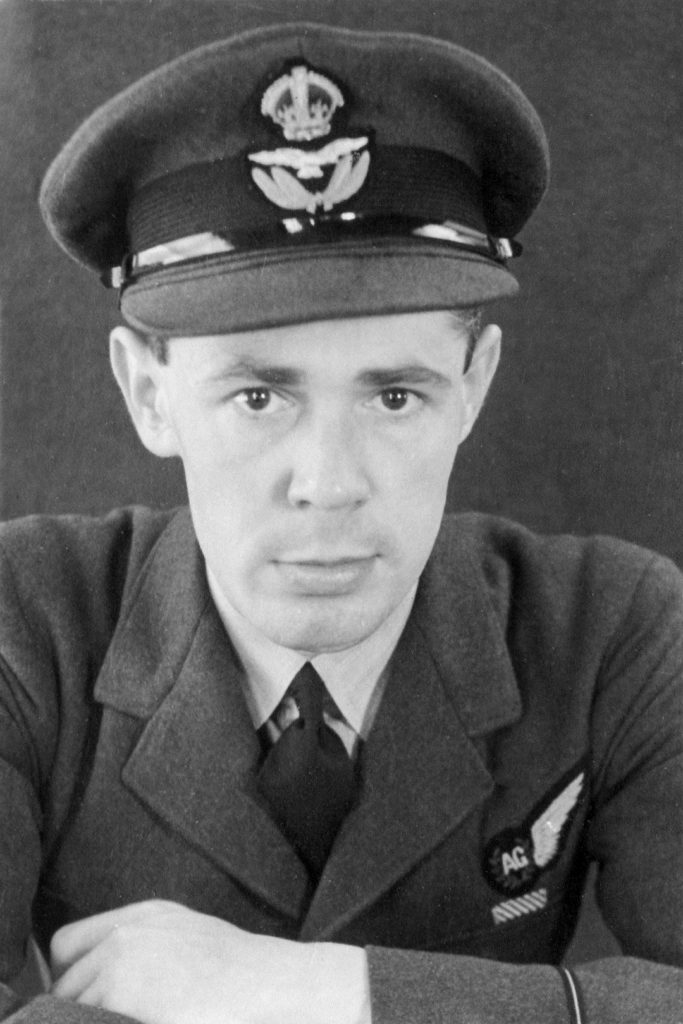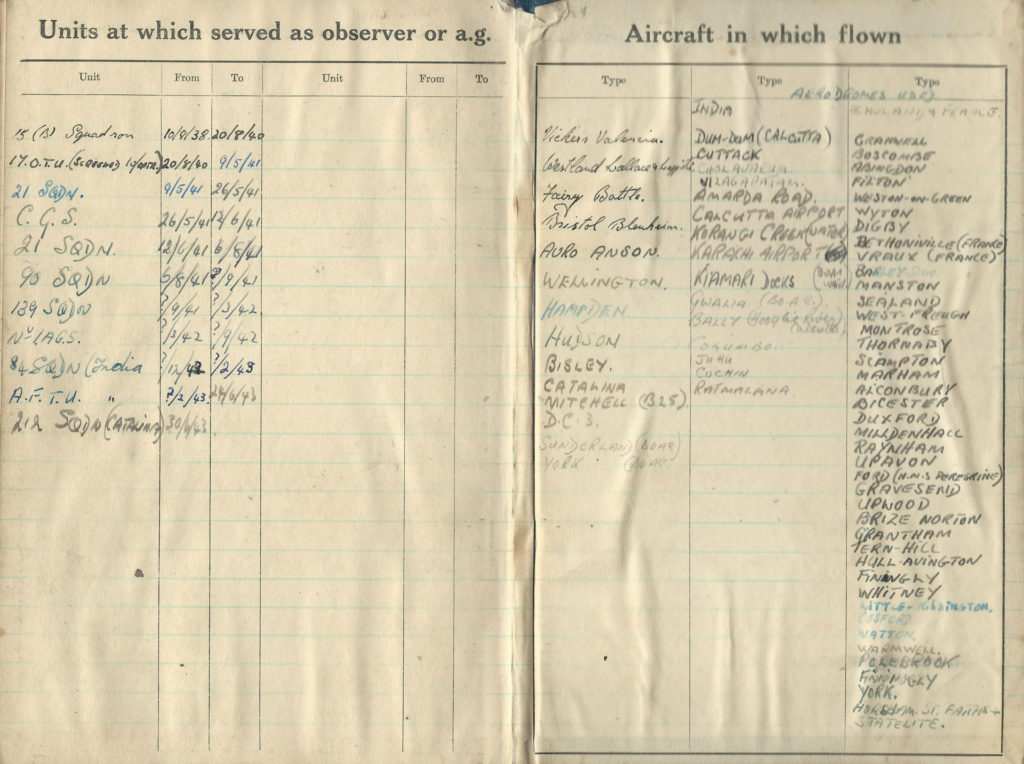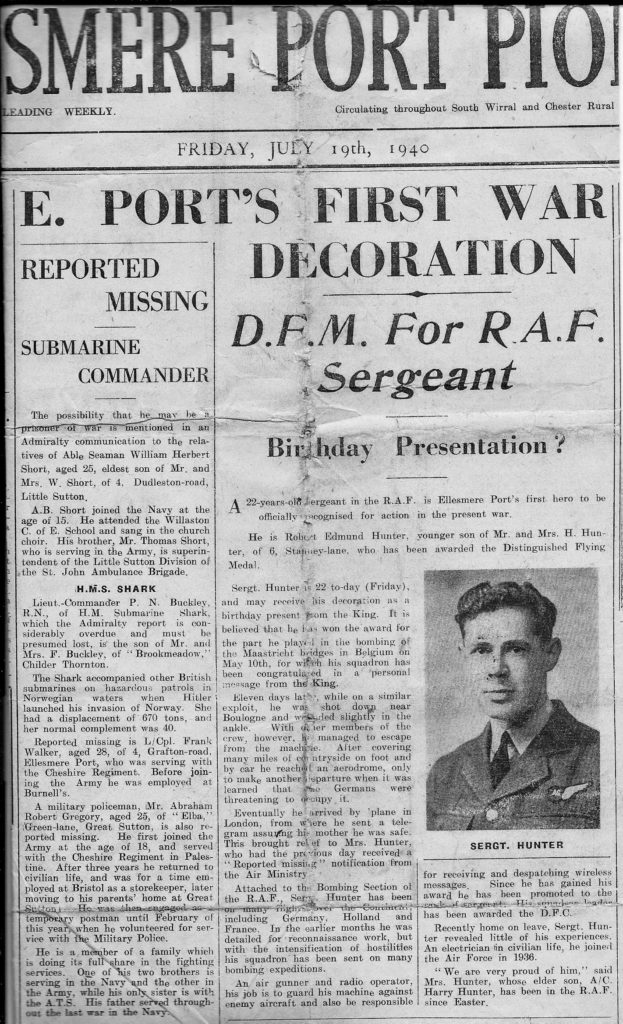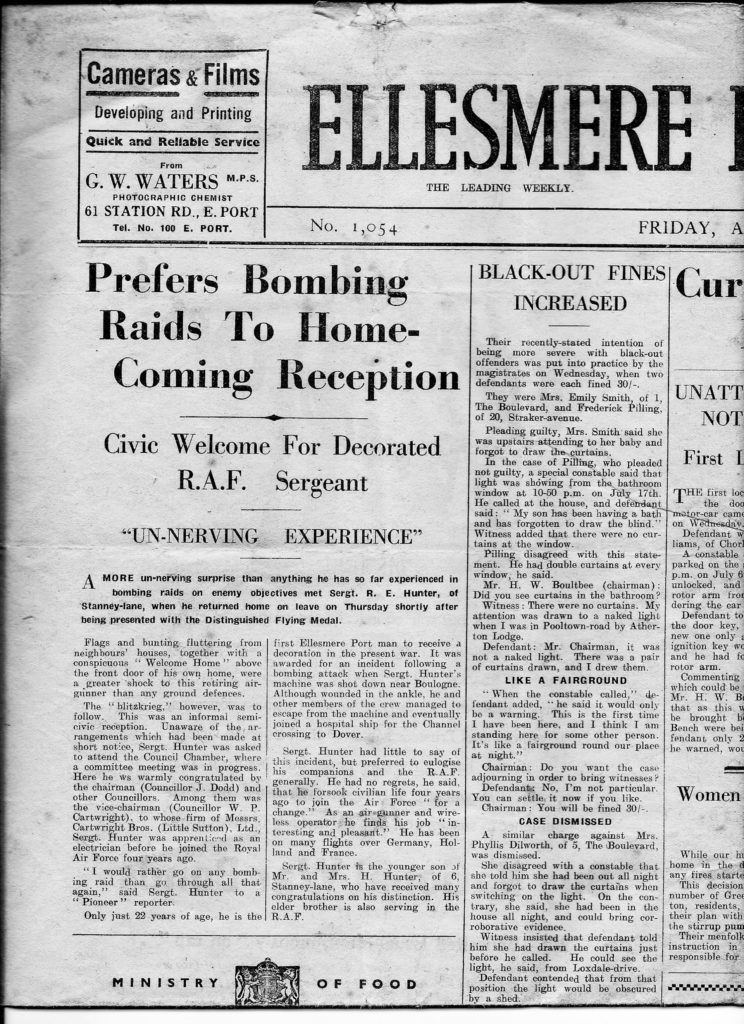This biography was authored by Rusty Russell and has been extracted from Mast High Over Rotterdam – Please respect Rusty’s Copyright to the work as detailed in the first section of the book.

Wartime crews often stuck together through various postings. Mostly, it was because they liked and respected each other; often, superstition was a factor, and to break up a crew could well court disaster. From all accounts, Tom Webster and Bob Hunter got on like a house on fire, and their partnership was to last from September 1939 until November 1941, from Battles on XV Squadron through Blenheims on 21 Squadron and finally Fortresses on 90 Squadron.
![Bob Hunter's trusty steed on XV Sqn, Abingdon, in 1938 - Fairey Battle EF:F (Bob Hunter [son])](https://rafwatton.uk/wp-content/uploads/2020/07/Fairey-Battle-France-1024x593.jpg)
![Fairey Battle France in France (Bob Hunter [son])](https://rafwatton.uk/wp-content/uploads/2020/07/Fairey-Battle-in-France-1024x696.jpg)
Recognition was soon forthcoming, however, and by the end of the month Bob was a ‘temporary’ sergeant and received the award of the coveted DFM some eight weeks later, on 9th July (the same day that Wg Cdr Webster received his first DFC).
On 21 Squadron at Watton, Robbie Robertson remembers seeing Bob Hunter only when they were due to fly together. He describes him as ‘Nice, reliable and capable: medium build, reddish face, slightly dark, slightly stocky.’
Fellow WOp/AG, Jim Marsden, contributes the following: ‘He was a regular. He was a quiet unassuming fellow. His wildest outburst I ever heard was over France, where a spent bullet hit him. You know, do you remember, there was a period in the lives of people when they wore, or they had, chrome mirrors – a piece of chrome that high – that you could look at yourself in and comb your hair. They had one in their tunic pocket there. And over France, and over the intercom, he said: “I’ve been hit – right over the heart!” And when he undid his tunic when he came back – I was with him – the bullet fell down! It had hit this mirror, and dented it: bruised his chest, and he thought it was serious, and he sweated blood. But it wasn’t. It must have been spent or it would have…yeah! But that was quite something. He was a serious-minded sort: nothing else I can say about him, really.’
This incident is best described in Bob Hunter’s own words. It followed a determined attack by a Messerschmitt Bf 109:
‘He came down very quickly from a great height, diving directly at us, and I very vividly recall my shocked surprise when whilst I was still looking with guns trained for positive identification (with so many of our own fighters about one tended to hesitate) my worst suspicions were confirmed when his leading edges began to wreath in smoke and flickering flame. Before I could get off a single shot I saw pieces being snatched out of the tail assembly and rear fuselage and sort of simultaneously an enormous clang in my turret and a blow on the chest which half knocked me off my seat…I was very rattled and confused and was concerned about a neat hole in my Mae West just over where my heart should have been. Very frightened, I unbuttoned my Mae West only to find a correspondingly clean hole in my Sidcot Suit underneath. My courage failed completely at this point and I couldn’t investigate any further. It was a funny experience – unreal somehow – like a nightmare. I sort of felt that if I didn’t see the wound maybe I wouldn’t die – or maybe I was dead and it was just my spirit looking at myself from outside. Anyway, I just sat as still and quiet as possible until we got home.’
‘Arriving back at base we landed unknowingly with a shot-up tyre, amongst other things, and as our speed fell off and braking applied, of course, the aircraft spun round a couple of times without collapsing the undercarriage before finally coming to a stop in a cloud of dust. On observing our arrival, the Blood Wagon, complete with MO, came haring out to enquire if all was well. After we had all reassured him with regard to the landing I nervously but casually asked “Would you have a look at this, Doc?”, pointing to the hole in my Mae West. “Let’s have a see, then!” (or words to that effect) from a cheerful, unalarmed doctor, worked wonders on my morale and I began to think that maybe I wouldn’t be bound to die after all. So right there and then, in the middle of the airfield, I opened up enough buttons and zip fasteners to give him a peek. Under the Sidcot Suit the hole continued into my battledress blouse (just under the flap of the left hand top pocket and towards inside corner) but wonder of wonders – no hole in my shirt – just a peppering of fine small cuts. The chest itself had a big angry-looking bruise with only a few light scratches and must have been numbed, I think, which probably enhanced the unreal sensation I had felt. As I went through the stripping performance, I felt something weighty slip down my Sidcot leg and come to rest against my foot – the sharp end of a 20mm armour-piercing cannon shell. The Doc suggested a check-over in Sick Quarters and feeling very relieved and important I was carried off the airfield in the Blood Wagon. The check-over confirmed nothing broken, just severe bruising which progressively became more painful and spread from shoulder to waist, passing through all the colours of the rainbow. The contents of my battledress pocket – a stainless steel mirror (which undoubtedly saved more serious injury), fountain pen, pencil and small metal cross with the Lord’s Prayer on the back – were buckled and shattered, but along with the 20mm shell [possibly 15mm] are my most treasured souvenirs. My “line shoot” battledress tunic was eventually left behind on changing stations and I could have cried my eyes out for it. For a couple of days I was the hero of the hour and came in for special treatment in the Mess, the N.A.A.F.I. and amongst the WAAFs generally – and I loved it. No doubt the shell was a ricochet off some part of the gun mountings but it was as near a direct bull’s-eye as one could ever get, and get away with it, and I never recall this experience without associating it with a mental picture of the evening beforehand – when I had been finding it difficult to get off to sleep, going through a head counting session: you know the sort of thing, how many had gone, how many were left. The Law of Averages said my turn was overdue, how would it come etc etc – and I remember that I finally handed the problem over to God. I told myself that if God didn’t want me to die, it would be possible for a 109 to have a close-range point-blank shot at me and still miss, and that is precisely what happened that following day. I have never been particularly religious and I seldom feel the need to go to church today, but I feel duty-bound and will always be happy to say that “I believe there is a God”.’
![Memoirs of a near-death experience. Was it the stainless steel mirror (not shown) that stopped the shell, or the power of the cross? (Bob Hunter [son])](https://rafwatton.uk/wp-content/uploads/2020/07/20mm-shell-souvenirs-1024x796.jpg)
Sqn Ldr Bob Hunter saw the cessation of hostilities in the Far East, and following staff and training duties back in UK, he finally left the service in February 1948.
In this strange world of coincidences, my letter to a Sqn Ldr R.E. Hunter proved no exception. Not for the first time did the recipient of one of my hopeful letters have to apologise for not being the correct person! Roger Hunter had been a pilot, and had won the DFC. Disappointed at having failed yet again, I was intrigued to read from Roger’s letter that he was connected through marriage with the sister of Flt Lt Charles Tunks, the Intelligence Officer at Watton at the time of the Rotterdam raid. And could he have a photograph of that debriefing… Furthermore, Roger’s favourite pub was the Baker’s Arms in Winchester, which at that time was run by my sister-in-law!
But technology does not stand still. My old-fashioned methods of trying to contact veterans of the Rotterdam raid, or their next-of-kin, were well and truly superseded by the launch of Julian Horn’s excellent website, www.rafwatton.uk. In September 2015, I had a call from Tony Lowe, Hon Secretary of the Blenheim Society. Much to my delight, he informed me that relatives of Sqn Ldr R.E. Hunter DFM would like to contact me, having read my online version of Mast High Over Rotterdam. In no time at all, I received a letter from Mr R.D. ‘Bob’ Hunter, son of Sqn Ldr R.E. Hunter DFM. This time, he was the real McCoy – the WOp/AG to Wg Cdr Webster. How lucky is that? Bob’s letter included a typewritten extract (concerning the Rotterdam raid of 16th July 1941) from his father’s freehand notes to R. Kirby dated 8th March 1970, as well as a photocopy of the relevant page of Sqn Ldr Hunter’s logbook. I was thrilled to get these memories of the raid, even though the account of my cousin’s crash, and the fitment of cable cutters differed from the information already received. I drew a deep breath. This is what pukka aviation historians have to face all the time! As noted in my section on the raid itself, I have presented the evidence and invited readers to draw their own conclusions. However, I stand firm on my assessment (in the Epilogue) of the exact causes of my cousin’s crash into Waalhaven.
Click on any of the following for full size.
![A proud moment for Bob as he strides out after being awarded his DFM in 1940 (Bob Hunter [son])](https://rafwatton.uk/wp-content/uploads/2020/07/RE-Hunter-with-DFM.jpg)
![Bob Hunter's logbook page for July 1941 (Bob Hunter [son])](https://rafwatton.uk/wp-content/uploads/2020/07/R-E-Hunter-Logbook-page-July-1941-1024x742.jpg)



![Bob Hunter progressing through the ranks and decorations. From Left to Right: LAC WOp/AG, Sgt WOp/AG, to Sgt WOp/AG with coveted DFM (Bob Hunter [son])](https://rafwatton.uk/wp-content/uploads/2020/07/bob-hunter-comp-1024x506.jpg)
![Sqn Ldr R.E. Hunter DFM around the end of World War Two (Bob Hunter [son])](https://rafwatton.uk/wp-content/uploads/2020/07/bob-hunter-end-of-war-731x1024.jpg)
According to his son, Bob, Sqn Ldr Hunter had ‘always been very reticent to discuss his exploits during service with the RAF.’ Thank goodness a change of heart at the eleventh hour – just three and a half years before he passed away – led to a liaison with a Mr Bob Kirby, during which many recollections and notes were recorded for posterity. Michael Bowyer used some of these to enrich his mammoth tome 2 GROUP R.A.F. Such memories relive what it was like to be Blenheim aircrew at this very dangerous phase of World War Two.
